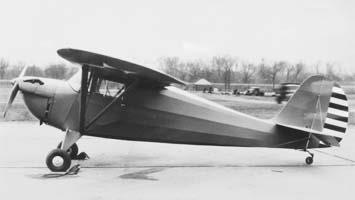| Type |
Two-seat sportplane |
| Engine |
1 Continental A-50 |
| Dimensions |
Length 6,40 m , height 2,0 m , span 10,97 m, wing area 15,70 m2 , |
| Weights |
Empty 599 lg, loaded , max. take off weight |
| Performance |
Max.. speed 174 km/h, cruising speed 153 km/h , range 418 km, endurance , service ceiling 4500 m , climb |
| Type |
Werk.Nr |
Registration |
History |
|
|
HB-UPU, D-EMON |
C Schlotterbeck/Basel-Birsfelden 29.03.39. Sold to Germany |

The Aeronca 50 Chief is a light two-seat general purpose aircraft mass-produced in the United States by Aeronca Aircraft Inc from 1938 to 1940. During this time, 430 aircraft were produced in various modifications.
The aircraft was developed from the Aeronca K Scout as an upgrade to the K series. However, by 1938, the competitive situation in the economy aircraft market had changed, and the Aeronca could not compete on price with Piper Aircraft's Piper J-3 Cub.
Bringing the 50 series aircraft to market at twice the price of Piper could end in complete failure. As an advertising campaign to demonstrate the reliability of the new aircraft, pilot Johnny Jones flew an Aeronca 50C Chief over a distance of 4,484 km between Los Angeles and New York in 30 hours and 47 minutes from November 29 to 30, 1938. The average flight speed was 145 km/h.
In 1938, airplanes sold for $1,795. Despite the rather high cost of the aircraft, its comfort and flight characteristics appealed to buyers and was in steady demand. In 1939 the price dropped to $1,695.
In 1939, Aeronca modernized the aircraft, giving it a new name - Aeronca 65 Super Chief. The main innovation was a stronger engine. In 1940, production of 50 series aircraft with 50-horsepower engines was discontinue
The plane is built according to the high-wing design. The fuselage was formed from aluminum pipes and beams covered with tarred durable fabric. The wings have a cellular structure. In the original, they were formed from spruce spars and stringers covered with fabric. The wings are supported from below by two metal struts each.
The landing gear is fixed, with a steering tail wheel. The cabin is fully glazed, heated and illuminated. The pilot and passenger are next to each other. Behind them there is a luggage rack.
The propeller is two-bladed, installed in the front part of the fuselage. The propeller fixed pitch
